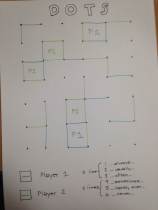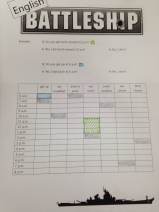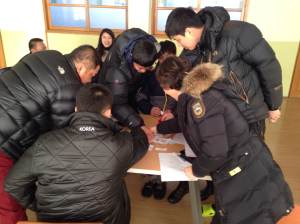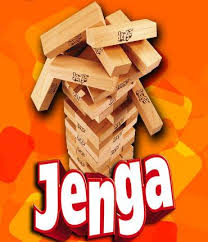As an ESL teacher working with middle school, high school, and adult students, I am always on the lookout for games that are fun and appropriate for a variety of skill levels and ages. Below is a collection of games that I’ve found to meet those standards! If you have any ideas of your own, questions, or feedback, feel free to leave them in the comment section!
1. Dots
 Materials: Paper with pre-drawn dot grid, pens/pencils, dice
Materials: Paper with pre-drawn dot grid, pens/pencils, dice
How to play: This two-person game is a variation on the regular “dot game,” where a grid of dots (with dimensions of your choosing) is printed on a piece of paper. Normally, players take turns drawing one line at a time each. When four lines are drawn and a square within the grid is completed, the person who completed the square “claims” it as their own by writing their initial in it. The objective is to claim more squares than your opponent by the end.
In this version, the objective is the same: to claim the most squares. The twist, though, is that before each person’s turn, he/she rolls the dice. Numbers 1-3 mean they can only draw one line. Numbers 4-6 mean they can drawn two lines, anywhere they like. Additionally, the number rolled with the dice is tied to certain vocabulary words. For example, when teaching adverbs of frequency, a 1 = “always,” 2 = “usually,” 3 = “often,” 4 = “sometimes,” 5 =”hardly ever,” and 6 =”never.” So before drawing the line(s), student must make a sentence that incorporates the vocabulary word. If you want to slow the game down, then you can eliminate the first dice rule. But I think it’s more interesting to leave it in. You could also pair students up into two-person teams. It’s very open-ended, so the vocab they use and the sentences they make should always be within their abilities.
Recap:
- Player 1 rolls the dice.
- Player 1 makes a sentence with the corresponding vocab word.
- Player 1 draws one or two lines on the grid.
- Player 2 rolls the dice, makes a sentence and draws a line or two.
- When a square is completed, the player who completed it claims the square by writing his/her first initial.
- The player with the most squares at the end wins.
2. English Battleship
 Materials: Battleship grid printed on paper, pens/pencils
Materials: Battleship grid printed on paper, pens/pencils
*Disclaimer* So, I’ve never actually played battleship (and I have yet to try this game with my class), but in theory/my head it should work really well. Also, it may seem complicated, but once you understand it, the game actually becomes pretty repetitive/simple *End disclaimer*
How to play: In regular battleship, the goal is to sink all of your opponent’s ships. You do so by guessing the ship’s coordinates. If you guess correctly, the ship gets “hit” and sinks…right? Right. In ENGLISH battleship, the first step is to speak in a British accent. … Just kidding. The first step is to make a coordinates grid using target language/vocab. When I designed this game, I was planning a lesson on telling the time and talking about daily activities. So, on the horizontal axis, I had seven activities. And on the vertical axis, I made an hourly time table.
To play, students first randomly fill in one square per column (or choose one time of day for each activity). These seven filled-in squares are their “boats,” which their opponent will try to sink by guessing the correct time/”location.” To locate the boat, their opponent asks a series of 2 questions that involve words from the x and y axes: the first question tells them the general vacinity of the boat, giving them a 3-hour timeframe that narrows down where the boat is. Once they successfully find the general location of the boat, they move onto the second question, which is a precise guess at the exact location of the boat; their attempt to sink it. The player who sinks his/her opponent’s entire “fleet” first, wins.
Recap:
- Fill in one square per column, designating your “boat” locations.
- Player 1 asks a general question, “Do you eat lunch around 12 pm?”
- Player 2 responds “Yes, I do,” or “No, I don’t.” A “yes” means their boat lies in the 11am, 12pm or 1pm windows of the “eat lunch” column. A “no” means their boat lies outside of the 11am-1pm timeframe.
- Player 2 asks a general question, “Do you _____ around ____am/pm?”
- Player 1 responds with a “yes” or “no.”
- Player 1 asks a specific question if their general question was successful. “Do you eat lunch at 11am?” If their general question failed before, they ask a different general question, “Do you eat lunch around 3pm?”
- Player 2 responds with a “yes” or “no.” If Player 1’s specific question is successful/correct, they have sunken Player 2’s ship! If the specific question is not correct/unsuccessful, then the ship is still out there, lying in the 12pm or 1 pm timeframe.
- Players can ask a specific question whenever they want, but it’s to their advantage to always ask a general question first. Good luck!
3. Slap the card
 Materials: Flashcards with vocab words, as many as you like (though a minimum of 8 is best)
Materials: Flashcards with vocab words, as many as you like (though a minimum of 8 is best)
How to play: Print the vocab words onto flashcards and laminate them (the cards will take quite a beating after just one game…you’ll see why in a second). Divide students into groups of 4 or 5. Groups of 3 are ok, but not ideal.
With the cards lying face up on the table, students try to be the first person to hit the correct card upon hearing a given word. The “given word” might be the same word that is printed on the card, it could be an opposite, something that is related/similar to the word, a word that starts or ends with the same letter, etc. At first, the teacher is the one calling out the given word. But, once students get the hang of it, it works great to hand them the reigns and let them take turns calling out the word. Of course, when they are the “word caller” they don’t get to participate in the slapping. The person with the most cards at the end wins.
This game worked really well with all of my students (middle school, high school, and adults). They all go crazy over the competition/speed aspect.
Recap:
- Lay the cards face up in the middle of the 4-5 person groups.
- Call out a given word.
- The student who slaps the card first, gets to keep it.
- Eventually allow students to call out the words.
- The person with the most cards at the end wins.
4. Jenga!
 Materials: Jenga blocks, vocabulary/sentence sheet
Materials: Jenga blocks, vocabulary/sentence sheet
How to play: Number the Jenga blocks 1-54, or however many blocks there are. Each block corresponds to a specific word or sentence written on a separate sheet of paper. When a student successfully removes a block, they must say the corresponding word/sentence, or create their own sentence. If your students have limited vocabulary or ability, feel free to double or triple up the words/sentences (e.g., numbers 1-5 belong to one word, numbers 6-10 belong to one word, etc).
Recap:
1) Number the jenga blocks. 2) Create a corresponding vocabulary/sentence sheet (doubling/tripling up words, if necessary). 3) Play Jenga! Remove a block and say the corresponding word/sentence.
5. Tennis Vocab
How to play: In pairs, students take turns firing off vocabulary words within a specific category or theme. The person who gets stumped or takes too long to come up with a response, loses. The winner gets a point. Most points over all, wins. You can do this with general vocabulary categories, or put a twist on it (e.g., gender opposites in family vocab [I say brother, you say sister; aunt, uncle; mother, father; etc], sinonyms or antonyms).
After students have played one-on-one for awhile, arrange them into two bigger teams for a “face-off.” Students still compete one-on-one, one pair at a time, but their performance/score goes towards that of the overall team. If need be, you can put a time limit on them as well (30 seconds or a minute). The team with the most points at the end, wins.
Recap:
- Separate students into pairs.
- Give them a category or theme (family, clothes, feelings, food, colors, similes, opposites, words that start or rhyme with ____)
- When they get stumped or falter, the other person gets a point. Most points at the end, wins.
- Combine students into two large teams for a face-off.
- Same rules apply as before.
- Time limit optional.
To view the original post and other great content, visit Korealizations at:
http://korealizations.wordpress.com
Like Korealizations on Facebook and subscribe on YouTube! Thanks for reading!



Recent comments